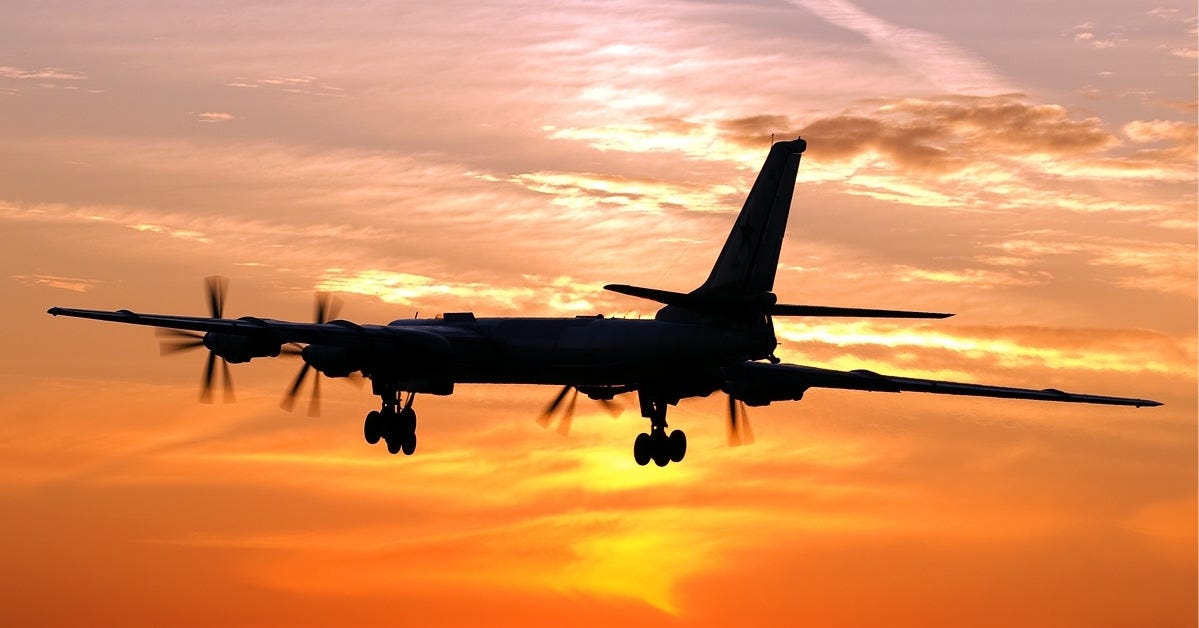Russia's Bear Bombers Are Quitting the War
Fewer Tu-95MS sorties means fewer strikes on Ukraine's cities
The Russian Bear bombers that survived the Ukrainian drone raid last month have fled east, away from Ukraine—and now appear to be flying less often and firing fewer missiles at Ukrainian cities.
In other words, the Ukrainian raid achieved its strategic goal.
On June 1, the Ukrainian state security agency—the vaunted SBU—smuggled more than 100 tiny explosive drones across Russia inside trucks and bombarded five air bases. When the smoke cleared, no fewer than 11 Tupolev bombers were destroyed or badly damaged: seven propeller-driven Tu-95MS Bears and four jet-propelled Tu-22M3s.
On paper, the Russian air force possessed just shy of 120 bombers before the raid: around four dozen Tu-95s, 50-plus Tu-22Ms and 15 or 16 Tu-160s. In fact, just 80 or so of the bombers may have been flightworthy.
Of those, only the Tu-95MSs were playing a major role in Russia’s 41-month wider war on Ukraine, routinely firing Kh-101 cruise missiles—eight per bomber per sortie—at Ukrainian cities.
According to aviation expert Tom Cooper, however, just 10 to 12 of the 35-year-old—or older—Bears were regularly active, owing to the planes’ age and complexity and the sheer effort required to keep them airworthy.
So when Ukrainian drones struck seven of the lumbering bombers on June 1, it may have eliminated a significant portion of the active fleet. There’s growing evidence that’s the case.
In the weeks following the June 1 drone raid, the Russian air force relocated most or all of the flyable Tu-95s to safer bases. Prior to the wider war, the air force’s sole Bear regiment flew from Engels-2 air base, just 375 miles from Ukraine. Now, 38 of the 44 Tu-95MSs that analysis group AviVector could identify are at Ukrainka air base, 3,700 miles from Ukraine.
Bears retreating!
By eliminating a significant portion of Russia’s cruise-missile carriers and forcing the survivors to stage from bases much farther to the east, the Ukrainian drone raid “should dramatically reduce Russia’s ability to launch missiles against Ukrainian cities and kill civilians,” Ben Hodges, a retired U.S. Army general, predicted as the bombers struck in the raid were still burning.
Not only are there fewer bombers—and remember, the Tu-95MS is no longer in production—the bombers that remain must fly farther to fire their 2,200-mile-range Kh-101s at Kyiv and other cities. That adds wear and tear and further complicates the already-difficult maintenance of the unreliable Bears.
It should come as no surprise, then, that Kh-101 strikes are waning. On May 25, the Russians launched 45 cruise missiles at Ukrainian cities, including Kh-101s from at least one Tu-95MS. A week later, the Ukrainian drones struck—and from that day on, the number of cruise missiles winging toward Ukrainian cities dwindled.
A July 10 raid involved just six Kh-101s. A follow-on attack two days later involved 25 of the missiles, but even that was an outlier. Most Russian raids now include just a handful of cruise missiles.
The withering of the Russian cruise missile campaign actually began around the New Year, according to the Institute for the Study of War in Washington, D.C. “Russian forces have used fewer cruise missiles in strike packages since January 2025,” ISW noted.
One explanation, ISW posited, is that the Kremlin is stockpiling many of the roughly 600 Kh-101s it builds every year at a cost of around $10 million per missile. But the slow degradation of the Tu-95MS fleet is another possible explanation. The June 1 drone strikes shrank the fleet and greatly accelerated what is surely a downward readiness trend.
In destroying and stressing the Bears, the SBU is sparing Ukrainian cities from certain kinds of Russian attacks. But the Russians are adapting. ISW warned that the decrease in Kh-101 attacks belies the enormous increase in attacks by Russia’s Shahed drones.
$200,000 Shaheds now account for the vast majority of the munitions hitting Ukrainian cities. The July 10 raid involved 397 Shaheds. The July 12 raid involved 597 of the drones, each packing a 200-pound warhead. A Kh-101 hits harder with its 900-pound warhead, but the drones compensate with sheer numbers.
It took Ukraine’s SBU more than a year of intensive planning to pull off the June 1 operation. Pummeled by drones, Ukrainian cities probably can’t wait another year for Ukrainian forces to execute a decisive attack on the Shahed infrastructure.
Read more:
Hammered by 2,700 Drones in a Month, Ukraine Is Losing the Shahed War
In three years, Russia has launched 28,734 Shahed attack drones at Ukrainian positions and cities.








If Russia is holding back key assets like armor and aircraft so they aren’t left “defenseless” against NATO, that’s not a good sign for their offensive war effort in Ukraine, huh?